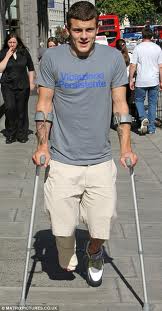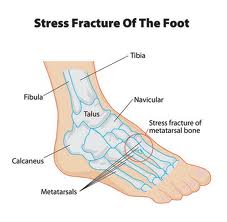Main Menu
Latest Blog Entry
User login
What does Jack Wilshere have in common with a Dinosaur?
 They both suffer from stress fractures!
They both suffer from stress fractures!
Poor old Jack Wilshere will be watching the Champion’s League Final from the comfort of his own home this week.
Could he have helped Arsenal get to the final if he hadn’t suffered from a stress fracture in training?
Physiotherapist Sarah Marshall looks at what we know about stress fractures and how to prevent them.
The human problem
Stress fractures in the human population were first reported in military recruits in the 19th century. A stress fracture is an incomplete fracture and caused by a repeated overload to a focal point of bone.
These injuries can occur in virtually any bone in the body but they are more commonly seen in weight bearing bones amongst runners and footballers e.g. tibia and metatarsals.
There are many predisposing factors which can contribute to a stress fracture such as:
- poor mechanics
- muscle weakness / imbalance
- training errors
- poor footwear / training environment
- inadequate nutrition (Vitamin D deficiency)
Getting the diagnosis
 Stress fractures are often difficult to diagnose. Many athletes will have continued with their sport for many months before seeking medical attention. Some key things to consider are:
Stress fractures are often difficult to diagnose. Many athletes will have continued with their sport for many months before seeking medical attention. Some key things to consider are:
- Pain will be localised to the fracture site and specifically tender on palpation.
- Pain will be aggravated by the precipitating activity, becoming severe towards the end.
- Swelling or bruising is not commonly seen.
- An x-ray appearance is often normal although signs of repair can be seen at times.
- MRI and CT scans are the investigation of choice.
5 things to consider in management of a stress fracture
- Relative rest is the initial treatment of all stress fractures. If the stress fracture occurs in a weight bearing bone complete rest and / or a cast or walking boot may be prescribed for up to 8 weeks (or longer in more severe cases).
- The amount of recovery time and degree of rest will vary on the location, severity and healing response of the individual.
- Return to sport and activity must be a gradual process to enable the bone to adapt to an increased load again.
- Further use of investigations are not useful during this rehabilitative phase as they can be deceptive i.e. the fracture site can still be visible even when the bone itself has fully healed.
- Healing is best assessed clinically by the absence of tenderness on palpation and a pain free precipitating activity.
What have Dinosaurs got to do with it?
 A study was published by Bruce Rothschild and other palaeontologists back in 2001 which studied and confirmed the presence of stress fractures in Theropod dinosaurs.
A study was published by Bruce Rothschild and other palaeontologists back in 2001 which studied and confirmed the presence of stress fractures in Theropod dinosaurs.
They were able to conclude that Theropods probably sustained these overuse injuries in the lower end of their third metatarsals whilst holding struggling prey with its feet.
Don’t train like a Dinosaur (Or Jack): Follow a correct training programme (see here)
Always seek medical advice before commencing a running regime if you suffer from an illness or have a musculo-skeletal disorder or injury.
Sarah Marshall
Client Testimonials
 South WestFencing Hub
South WestFencing Hub
Working with James has been a pleasure and education for all of the fencers and coaches, from beginner fencers and trainee fencers, up to international fencers and coaches with decades of experience. We really appreciate James' desire to challenge assumptions but simultaneously his ability to listen to both fencers and coaches on technical and tactical points. He manages to keep his sessions fresh and innovative without losing sight of our central goals. His sessions are challenging and fun and his attention detail is a tribute to his professionalism. Thank you.
More


Comments
[…] mention goes to “What does Jack Wilshere have in common with a Dinosaur?” by Physiotherapist Sarah Marshall which helps explain why he is always […]
[…] can now tell when a player is more likely to get injured – Jack Wilshere having played so many games during the 2010-2011 season that he could not attend the under 21 […]